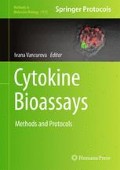Abstract
The immunosuppressive cytokines transforming growth factor β1 (TGFβ1) and interleukin-10 (IL-10) regulate a variety of biological processes including differentiation, proliferation, tissue repair, tumorigenesis, inflammation, and host defense. Aberrant expression of TGFβ1 and IL-10 has been associated with many types of autoimmune and inflammatory disorders, as well as with many types of cancer and leukemia. Patients with cutaneous T cell lymphoma (CTCL) have high levels of malignant CD4+ T cells expressing IL-10 and TGFβ1 that suppress the immune system and diminish the antitumor responses. The transcriptional regulation of TGFβ1 and IL-10 expression is orchestrated by several transcription factors, including NFκB. However, while the transcriptional regulation of pro-inflammatory and anti-apoptotic genes by NFκB has been studied extensively, much less is known about the NFκB regulation of immunosuppressive genes. In this chapter, we describe a protocol that uses chromatin immunoprecipitation (ChIP) to analyze the transcriptional regulation of TGFβ1 and IL-10 by measuring recruitment of NFκB p65, p50, c-Rel, Rel-B, and p52 subunits to TGFβ1 and IL-10 promoters in human CTCL Hut-78 cells.
Access this chapter
Tax calculation will be finalised at checkout
Purchases are for personal use only
References
Berger CL, Tigelaar R, Cohen J et al (2005) Cutaneous T-cell lymphoma: malignant proliferation of T-regulatory cells. Blood 105: 1640–1647
Querfeld C, Rosen ST, Guitart J et al (2005) The spectrum of cutaneous T-cell lymphomas: new insights into biology and therapy. Curr Opin Hematol 12:273–278
Saed G, Fivenson DP, Naidu Y et al (1994) Mycosis fungoides exhibits a Th1-type cell-mediated cytokine profile whereas Sezary syndrome expresses a Th2-type profile. J Invest Dermatol 103:29–33
Chong BF, Wilson AJ, Gibson HM et al (2008) Immune function abnormalities in peripheral blood mononuclear cell cytokine expression differentiates stages of cutaneous T-cell lymphoma/mycosis fungoides. Clin Cancer Res 14:646–653
Abraham RM, Zhang Q, Odum N et al (2011) The role of cytokine signaling in the pathogenesis of cutaneous T-cell lymphoma. Cancer Biol Ther 12:1019–1022
Krejsgaard T, Odum N, Geisler C et al (2012) Regulatory T cells and immunodeficiency in mycosis fungoides and Sezary syndrome. Leukemia 26:424–432
Qin JZ, Nestle FO, Häffner A et al (1997) Cutaneous T cell lymphoma cells contain constitutive NFκB complexes. J Invest Derm 108:225
Döbbeling U, Qin JZ, Dummer R et al (1998) Suppressors of constitutive NFκB activities in CTCL cells induce apoptosis. Arch Dermatol Res 290:58
Izban KF, Ergin M, Qin JZ et al (2000) Constitutive expression of NFκB is a characteristic feature of mycosis fungoides: implications for apoptosis resistance and pathogenesis. Hum Pathol 31:1482–1490
Sors A, Jean-Louis F, Pellet C et al (2006) Down-regulating constitutive activation of the NFκB canonical pathway overcomes the resistance of cutaneous T-cell lymphoma to apoptosis. Blood 107:2354–2363
Sors A, Jean-Louis F, Bégué E et al (2008) Inhibition of IκB kinase subunit 2 in cutaneous T-cell lymphoma down-regulates NFκB constitutive activation, induces cell death, and potentiates the apoptotic response to antineoplastic chemotherapeutic agents. Clin Cancer Res 14: 901–911
Kiessling MK, Klemke CD, Kaminski MM et al (2009) Inhibition of constitutively activated NFκB induces reactive oxygen species- and iron-dependent cell death in cutaneous T-cell lymphoma. Cancer Res 69:2365–2374
Giri DK, Aggarwal BB (1998) Constitutive activation of NFκB causes resistance to apoptosis in human cutaneous T cell lymphoma HuT-78 cells. Autocrine role of tumor necrosis factor and reactive oxygen intermediates. J Biol Chem 273:14008–14014
O’Connell MA, Cleere R, Long A et al (1995) Cellular proliferation and activation of NFκB are induced by autocrine production of TNFα in the human T lymphoma line HuT-78. J Biol Chem 270:7399–7404
Mori N, Prager D (1997) Activation of the interleukin-10 gene in the human T lymphoma line HuT-78: identification and characterization of NFκB binding sites in the regulatory region of the interleukin-10 gene. Eur J Haematol 59:162–170
Mori N, Prager D (1998) Interleukin-10 gene expression and adult T-cell leukemia. Leuk Lymphoma 29:239–248
Hayden MS, Ghosh S (2012) NFκB, the first quarter-century: remarkable progress and outstanding questions. Genes Dev 26:203–234
Wan F, Lenardo MJ (2009) Specification of DNA binding activity of NFκB proteins. Cold Spring Harb Perspect Biol 1:a000067
Hayden MS, Ghosh S (2008) Shared principles in NFκB signaling. Cell 132:3344–3362
Yamamoto Y, Gaynor RB (2001) Therapeutic potential of inhibition of the NFκB pathway in the treatment of inflammation and cancer. J Clin Invest 107:135–142
Aggarwal BB (2004) NFκB: the enemy within. Cancer Cell 6:203–208
Naugler WE, Karin M (2008) NFκB and cancer-identifying targets and mechanisms. Curr Opin Genet Dev 18:19–26
Sun SC (2012) The noncanonical NFκB pathway. Immunol Rev 246:125–140
Hoffmann A, Natoli G, Ghosh G (2006) Transcriptional regulation via the NFκB signaling module. Oncogene 25:6706–6716
Wan F, Lenardo MJ (2010) The nuclear signaling of NFκB: current knowledge, new insights, and future perspectives. Cell Res 20:24–33
Natoli G (2012) NFκB and chromatin: ten years on the path from basic mechanisms to candidate drugs. Immunol Rev 246:183–192
Juvekar A, Ramaswami S, Manna S et al (2012) Electrophoretic mobility shift assay analysis of NFκB transcriptional regulation by nuclear IκBα. Methods Mol Biol 809:49–62
Juvekar A, Manna S, Ramaswami S et al (2011) Bortezomib induces nuclear translocation of IκBα resulting in gene-specific suppression of NFκB-dependent transcription and induction of apoptosis in CTCL. Mol Cancer Res 9: 183–194
Chang TP, Vancurova I (2013) NFκB function and regulation in cutaneous T-cell lymphoma. Am J Cancer Res 3:433–445
Acknowledgements
This work was supported by NIH grant CA173452 to I. Vancurova.
Author information
Authors and Affiliations
Corresponding author
Editor information
Editors and Affiliations
Rights and permissions
Copyright information
© 2014 Springer Science+Business Media, New York
About this protocol
Cite this protocol
Chang, TP., Kim, M., Vancurova, I. (2014). Analysis of TGFβ1 and IL-10 Transcriptional Regulation in CTCL Cells by Chromatin Immunoprecipitation. In: Vancurova, I. (eds) Cytokine Bioassays. Methods in Molecular Biology, vol 1172. Humana Press, New York, NY. https://doi.org/10.1007/978-1-4939-0928-5_30
Download citation
DOI: https://doi.org/10.1007/978-1-4939-0928-5_30
Published:
Publisher Name: Humana Press, New York, NY
Print ISBN: 978-1-4939-0927-8
Online ISBN: 978-1-4939-0928-5
eBook Packages: Springer Protocols

